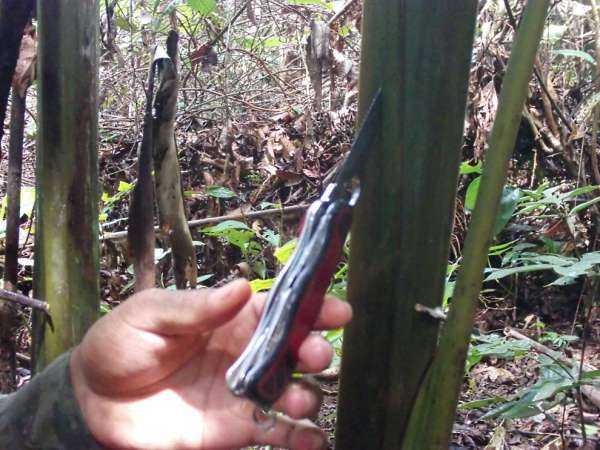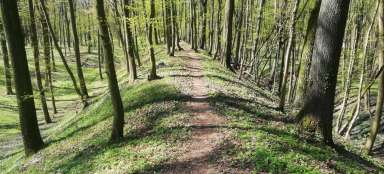How to get drinking water in the wilderness
How to survive in nature 2 - how to get water

Dehydration and lack of water can cause us very serious health problems. Where can we find water in nature and how to modify it to make it safe? We will focus on this in this article …
Dehydration
Even when idle, our body can easily consume a liter of water a day (digestion, breathing, urine production, sweating, etc.), at higher temperatures and physical exertion, this consumption increases. The body is unable to build up water supplies and the only way to prevent dehydration is to get a regular supply of fluids. Symptoms of dehydration: 1 – 5% loss of water in the body: Feeling thirsty, increased heart rate, nausea, weakness … 5 – 10% loss of water in the body: Dizziness, headache, breathing problems, blurred vision, tremor in the hands … 10 – 12% water loss in the body: Vision and hearing loss, convulsions, swollen tongue, difficulty swallowing, death
Finding water
In most parts of the world, surface water (watercourses, lakes, ponds …) can be found without major problems, which after treatment (filtration, boiling, chemical treatment, distillation …) can be relatively harmless and we do not risk the infection. We select the purest possible water, rather from running water and best on the upper streams or springs. But where to look for water when there is no water flow in range? In addition to watercourses, we can obtain water from nature in several other ways: – ** Rainwater, dew ** – ** Ice and snow ** – ** Dry riverbed ** – ** Plants and fruits ** – ** Rock depressions ** – ** Distillation of sea water ** – ** Groundwater ** – ** Napajedla ** – ** „Recycling“ of urine **
Rainwater, dew
Tanzania's smallest national park
This is the easiest and safest way to get water. It has only one „hook“, it has to rain … Rainwater is usually clean and usually doesn't even have to overcook (but boiling doesn't spoil anything and it's safer after all). We can catch rainwater, for example, in a tarpaulin, tent, waterproof clothing, plant leaves, etc. Always find out if waterproof materials do not contain any harmful and dangerous substances (impregnations, repellents, etc.), which can have a great impact on your health. Dew collection is also a way to obtain water. Collect the dew with a clean handkerchief or absorbent material (T-shirt, various clothes, etc.) and then squeeze into a suitable container. It won't be much, but every drop counts in an emergency … For example, you can tie absorbent clothes to a piece of stick and „grind“ it on the surface of grass or other plants.
Ice and snow
If you are in areas where you have snow or ice available, you have water. You simply melt ice and snow near the fire or directly above it. Peel off the top layer of snow, then wrap it in a T-shirt or shirt (make it such a „bag“) and put it close to the fire. Gradually, the snow will thaw and drip into the prepared container. You can also put snow and ice in a bottle and melt it with body heat under clothing (but it will make you cold and you can speed up hypothermia).
Dry riverbed
Tanzania's smallest national park
When we see a dry riverbed, it does not necessarily mean that we cannot find water here. Water once flowed in dry riverbeds. Under almost every flowing river, there is a so-called „underground river“ underground. For example, the „underground“ Amazon has two-thirds more flow and volume than the Amazon we see on the surface. So if we dig deep enough in a dry riverbed, we can come across an underground river. Rather, we choose places on the outside of the river bend. There is usually a large amount of sand on the inner bends of the riverbed. We dig a hole in a dry riverbed and after a while water starts to seep into it. Of course, it may happen to us that the underground river is no longer in a dry riverbed. If you don't come across a trough at a depth of about half a meter even on damp sand, you don't have to dig any more, there is simply no water. You can try it in other places, but it will probably be just a waste of energy.
Plants and fruits
We do not always have to look for water as such, but we can also look for plants and fruits that contain a high percentage of water. In addition to liquids, they can supply us with sugars, vitamins and other beneficial substances. ** Plants **: May contain pulp or sap that contains a high percentage of water. In Europe, it can be birch sap (usually taken in early spring), where you just cut the bark and bast of the birch and you start to leak sap, which you capture in a prepared container (you can drip up to 2 liters of sweet sap at night). In South America, there are species of vines that contain large amounts of water that is even colder than the ambient air temperature. Personally, I was addicted to her for two whole days. The creeper with a diameter of about 6 cm and a length of less than one meter contained about 3 dcl of water. Other plants can catch rainwater from their leaves (such as a banana tree), where you just cut a part of the plant, from where the collected rainwater will start to flow. Another way to get water from plants is to wrap fresh leaves in a waterproof bag. Wrap part of the plant in plastic wrap and leave it in the sun. Due to the higher ambient temperature and humidity of the plant, water droplets begin to form inside the plastic. ** Fruit **: A large amount of fruit contains a high percentage of water in the flesh. Therefore, fruit collection can partially replace clean drinking water. Only collect fruits that you know and can pinpoint the species. Many fruits are also extremely poisonous. Some edible fruits can also have laxative effects (when consumed more).
Rock depressions
Rainwater is often trapped in rock fissures or depressions. Look for places with more moss on the rocks and places where there is shade for most of the day (northern sides of the rocks). Let the water from the rocks stand still, as it may contain a high percentage of washed-out material from the rocks. This material has strong laxative effects.
Distillation of sea water
If you move near the sea or the ocean, you can use distillation to make drinking water out of seawater. Sea water is not suitable for drinking, on the contrary. It contains a high percentage of salt, which causes faster dehydration. The easiest way to distill seawater is to boil it. Boil seawater on fire and use a handkerchief or absorbent clothing as a lid. At short intervals, squeeze the handkerchief into a suitable container and put it back on the boiling seawater. Another way may be distillation using two PET bottles and sunshine. Cut a larger PET bottle in half and insert the bottom of a smaller PET bottle (or a smaller can) into it. Pour seawater into a smaller PET bottle. Thread the top of the larger PET bottle onto the bottom of the larger PET bottle, cap and place in the sun. The seawater will evaporate in the PET bottle and flow down the sides into a large PET bottle.
Ground water
In wetter places, we can try to dig a hole with a diameter of about 30 cm and a depth of about half a meter. Over time, groundwater will start to seep into this hole. In the camping manuals we can find this technique under the name „Indian well“.
Watering holes
In drier areas of the Earth, where there is a shortage of water, there may be animal waterers. By following the animal tracks, we can find such a watering hole. They are mostly puddles and the water in them is very poor quality and contaminated with urine and animal faeces. However, if you have no other choice, it is drinkable with a high risk after treatment. Even after distillation, prepare for an unpleasant smell and not to mention the taste …
"Recycling" urine
Tanzania's smallest national park
Drinking your own urine is a controversial topic in survival. Some people are also treated with urine (urine therapy). But what about drinking urine in emergency situations? There are known cases where drinking urine saved people from death from dehydration. So there will probably be something to it. In addition to water, the urine also contains waste products from the body and salt (of course, also a lot of other substances and enzymes), so in my opinion, it will not be very suitable for drinking. But when we get to a situation where we have to use this option, he goes for it. First of all, we have to break down the mental block, because a lot of us just can't drink urine, and before it swallows, it starts to choke. When we manage to break down the mental block, a warm salty liquid awaits us with an unattractive taste and smell. When drinking urine, I recommend drinking immediately and not storing it in stock. It perishes quickly. In dehydration, when the urine is already very yellow, cloudy and smelly, I do not recommend drinking at all.
Coconut
A larger coconut can contain up to 0.5 liters of coconut water

Liana as a reservoir of water
For two days I was dependent only on this kind of lilac

Banana tree
The young banana tree is also a good source of water. After large leaves, rainwater flows into the interior of the banana tree.

Water purification and treatment
In most cases, drinking water does not occur in nature. But we have several ways to treat the water to reduce the risk of infection and infection. Methods of water treatment: ** Filtration ** ** Distillation ** ** Chemical treatment ** ** Boiling **
Filtration
Tanzania's smallest national park
- ** Industrially produced travel filters **: There are really many of them on the market. These filters work mainly on the principle of a fine membrane, which does not allow viruses or bacteria. – ** Improvised filter **: In an improvised PET bottle filter, into which you gradually insert moss, crushed charcoal from fire, sand and pebbles, it can help clean the water. You can find the construction of such a filter on the Internet. The components of this filter are intended to serve their purpose. Moss and sand is a fine natural material that is supposed to capture small particles of dirt. Carbons from the fireplace have a disinfecting function. The stones are intended to capture coarser dirt. In my tests of water filtration using an improvised filter made of PET, moss, carbon, sand and stones, I came to the opposite results. How many times did the water flowing out of the filter be of poorer quality than the water I poured into the filter. In my opinion, this is due to dirty and non-sterile material, which is the content of the filter. For example, sand can be contaminated with mold, manure, dirt from the river, etc. Moss and stones as well. I found a way out using only crushed carbons from a fire. They have an antibacterial effect and disinfect the water that flows through the filter. Sand can also be used, but I recommend „roasting“ it in a cauldron over a fire in advance. First, it begins to mate in the cauldron and begins to „stink“, then it is sterilized at high temperature. A women's tampon, through which we pour water, can also be used to filter water. – ** Rising water **: Pour the contaminated water into one container and insert a piece of absorbent substance into it so that the other end of the substance ends up in an empty clean container. Due to the wateriness of the water, we achieve that pure water will seep through the pure substance and drip into the second container. Filtration removes viruses and bacteria from the water, but not the chemicals that the water may contain. After filtration, I recommend boiling the water.
Distillation
We could hear the concept of distillation in physics or chemistry classes at school. It is a change of liquid in steam and its subsequent cooling leads to its condensation. Let the polluted water boil over the fire and catch the steam in the fabric. Then squeeze the fabric into the prepared container.
Chemical treatment
We have many types of chemical compounds on the market for water treatment and purification. These are usually either tablets or powder form. I personally own AquaSteril. There are two types of bags in the package. One is poured into the water and you wait 15 minutes, then you pour the other bag into the water and you can drink. In my opinion, this is one of the safest practices in water treatment. But it also has its „against“. Chemical disinfection of water destroys all bacteria, not only in purified water, but also in our body. Prolonged drinking of water treated in this way can result in the destruction of the intestinal microflora and subsequent problems with digestion and digestion.
Overcooking
Boiling water destroys most bacteria and viruses. It is generally recommended to boil the water for at least 15 minutes. We can boil water either over a fire or with the help of hot stones (heat for at least an hour in a fire), which we put into the water. By transferring heat from the stones to the water, our water begins to boil.
In the next article, we will take a closer look at catering in emergency situations.













